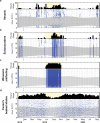Ultrasonic antifouling devices negatively impact Cuvier's beaked whales near Guadalupe Island, México
- PMID: 36138086
- PMCID: PMC9499979
- DOI: 10.1038/s42003-022-03959-9
Ultrasonic antifouling devices negatively impact Cuvier's beaked whales near Guadalupe Island, México
Abstract
Widespread use of unregulated acoustic technologies in maritime industries raises concerns about effects on acoustically sensitive marine fauna worldwide. Anthropogenic noise can disrupt behavior and may cause short- to long-term disturbance with possible population-level consequences, particularly for animals with a limited geographic range. Ultrasonic antifouling devices are commercially available, installed globally on a variety of vessel types, and are marketed as an environmentally-friendly method for biofouling control. Here we show that they can be an acoustic disturbance to marine wildlife, as seasonal operation of these hull-mounted systems by tourist vessels in the marine protected area of Guadalupe Island, México resulted in the reduced presence of a potentially resident population of Cuvier's beaked whales (Ziphius cavirostris). Human activities are rapidly altering soundscapes on local and global scales, and these findings highlight the need to identify key noise sources and assess their impacts on marine life to effectively manage oceanic ecosystems.
© 2022. The Author(s).
Conflict of interest statement
The authors declare no competing interests.
Figures






References
-
- Williams R, et al. Impacts of anthropogenic noise on marine life: Publication patterns, new discoveries, and future directions in research and management. Ocean Coast. Manag. 2015;115:17–24. doi: 10.1016/j.ocecoaman.2015.05.021. - DOI
-
- Chou E, Southall BL, Robards M, Rosenbaum HC. International policy, recommendations, actions and mitigation efforts of anthropogenic underwater noise. Ocean Coast. Manag. 2021;202:105427. doi: 10.1016/j.ocecoaman.2020.105427. - DOI
-
- Hildebrand JA. Anthropogenic and natural sources of ambient noise in the ocean. Mar. Ecol. Prog. Ser. 2009;395:5–20. doi: 10.3354/meps08353. - DOI
-
- Nowacek DP, Thorne LH, Johnston DW, Tyack PL. Responses of cetaceans to anthropogenic noise. Mamm. Rev. 2007;37:81–115. doi: 10.1111/j.1365-2907.2007.00104.x. - DOI
Publication types
MeSH terms
LinkOut - more resources
Full Text Sources
Other Literature Sources

